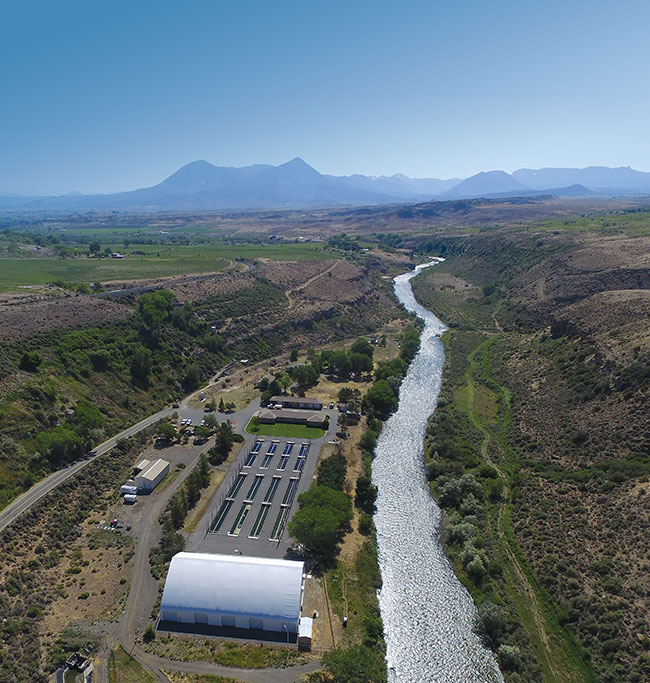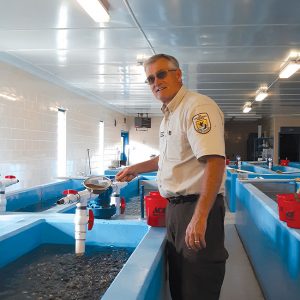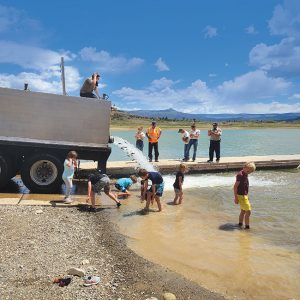
Features
Hotchkiss National Fish Hatchery: A lifeline for aquatic populations
The Hotchkiss National Fish Hatchery restores Colorado’s fish species today for the generations of tomorrow.
August 27, 2021 By Julia Hollister
 A drone photo of Hotchkiss Hatchery.
Photo: Kessner G.C., Inc.
A drone photo of Hotchkiss Hatchery.
Photo: Kessner G.C., Inc. Colorado’s Hotchkiss National Fish Hatchery (Hotchkiss NFH) began its first full year of production as a mitigation hatchery in 1970, and the need was overdue.
“The Upper Colorado River Storage Project Act of 1956 has had a significant impact on the development and management of water in the Upper Colorado River Basin (Colorado, New Mexico, Utah, and Wyoming) with the creation of built reservoirs,” said Hotchkiss project manager, Craig Eaton. “When dams were built and filled, it covered acres of wildlife habitat. To help mitigate for the loss of wildlife habitat, the Department of Interior built Hotchkiss NFH for stocking fish in some of these reservoirs.”
The hatchery is operated by the U.S. Fish and Wildlife Service (USFWS), built under the provisions of Section 8 of the Colorado River Storage Act, water development project. The facility includes 24 inside nursery tanks, 40 concrete raceways and two earthen ponds for treatment and sedimentation.
Hotchkiss NFH is a federal hatchery. There are two other federal hatcheries in Colorado: Leadville National Fish Hatchery, Leadville, and the Ouray National Fish Hatchery-Grand Valley Unit in Grand Junction.
Other hatcheries in Colorado are part of Colorado Parks and Wildlife.
“Hotchkiss’ most important mission is rearing and stocking of mitigation recreational trout in federal reservoirs for the Bureau of Reclamation and the U.S. Fish and Wildlife Service (USFWS),” Eaton continued. “We also meet our Tribal Trust responsibilities by stocking the Southern Ute Indian Tribe with trout.”
Explaining the restoration of aquatic populations and how this process benefits tribes, can be complicated.
Human-caused activities such as agricultural, mining, cattle grazing, timber harvesting, etc. have accelerated widespread alteration of watersheds, floodplains and riparian zones, adversely affecting aquatic plant and animal communities. Restoring these wetland habitats help plants and animals in rebuilding their aquatic populations. Reintroducing native plants and animals to the repaired habitat can also help kickstart their populations.
Hotchkiss NFH stocks the Southern Ute Indian Tribe (SUIT) waters as part of USFWS Tribal Trust responsibility. Selling fishing permits to non-tribal visitors for fishing waters on their reservation helps create funds to increase SUIT’s ability to restore habitat and aquatic populations. Other tribes are benefited through restoring aquatic populations because their culture evolves around certain fish species (e.g. salmon), and subsistence fisheries provide a much-needed food source for tribal communities.
USFWS supports tribal projects through Tribal Wildlife Grants Program. This program is a competitive grant program available to federally recognized Indian tribes to conserve fish, wildlife, plants, and their habitats.
Disease is the dark cloud that never seems to go away.
- Craig Eaton, project manager, Hotchkiss National Fish Hatchery in Colorado. Photo: Ben Prior
- Stocking a reservoir at Hotchkiss Hatchery. Photo: Katelynn Russell
If there is fish in a hatchery then disease management is always an ongoing problem, Eaton said. With the North Fork of the Gunnison River being a stone’s throw away from the main outside fish rearing raceways of Hotchkiss NFH, there are current and potential problems that occur and can occur, sometimes seasonally.
The decline of wild fish populations is also a looming concern.
“The decline is the reason fish hatcheries exist,” he said. “I believe that without fish hatcheries there wouldn’t be any recreational fishing, except on private lands. Hatcheries can help in rearing and rebuilding native populations, and stocking fish into areas where the public frequents can lessen fishing pressure on the wild fish, while allowing the public to catch stocked fish.”
There are four unique fish species that can only be found in the Colorado River system: Colorado Pikeminnow, Humpback Chub, Razorback Sucker, and the Bonytail.
Dale Ryden is the project leader of U.S. Fish and Wildlife Service at the Grand Junction Fish and Wildlife Conservation Office, and an expert in recovering endangered fish.
“Our hatchery here in Grand Junction, is called the Ouray National Fish Hatchery – Grand Valley Unit,” said Ryden. “It is a small hatchery that grows only endangered fish. Currently we have two endangered fish species on-station (Razorback Sucker, Xyrauchen texanus; and Bonytail, Gila elegans) that we culture and stock back into the wild.”
The entire reason for this hatchery’s existence is to help recover populations of these endangered Colorado River fish species and its tributaries. The hatchery stocks these species into the Colorado, Gunnison, and San Juan rivers in support of recovery efforts.
The hatchery currently stocks about 6,000 Razorback Sucker annually into the Colorado and Gunnison rivers, 10,000 Bonytail annually into the Colorado River, and 2,000 Razorback Sucker annually into the San Juan River.
All of the work is funded through, and overseen by, two endangered fish recovery programs: the Upper Colorado River Endangered Fish Recovery Program (UCREFRP), and the San Juan River Basin Recovery Implementation Program (SJRBRIP). Both of recovery programs are made up of numerous partner entities that range from federal, state, and tribal resource agencies to water user and environmental groups.
According to Eaton, there is a long list of challenges facing the 70 federal fish hatcheries.
Through U.S. Congress, the USFWS headquarters determines what the priorities are for the current controlling administration. The following are the top priorities of the National Fish Hatchery System, the funding comes from Bureau of Reclamation and from U.S. Fish and Wildlife Service, both agencies under the Department of Interior.
Hotchkiss NFH currently is in priority 3 (b &d), and 5 (a & b):
1. Recovery of aquatic species federally listed as threatened or endangered.
2. Restoration of imperiled aquatic species to restore to abundance, prevent further decline.
3. Tribal trust programs
- Tribal trust/non-discretionary – Programs specifically required by treaty or legislation or required or supervised by a court pursuant to a consent decree or court order.
- Tribal trust/general authority – Programs established under the authority of a treaty or legislation and operated under the USFWS’s general tribal trust responsibilities.
- Tribal fisheries/native fish – Programs not established or otherwise required by law, treaty, or litigation and operate to support tribal fisheries by propagating native fish species.
- Tribal fisheries/non-native fish- Programs not established or otherwise required by law, treaty, or litigation and operate to support tribal fisheries by propagating non-native fish species.
4. Native species
a. Native species propagation that fulfills mitigation obligations of other federal agencies and for which the USFWS is fully reimbursed by the mitigation agency.
b. Native species propagation that fulfills mitigation obligations of other federal agencies and for which the USFWS
is not fully reimbursed by the mitigation agency.
c. Native species propagation that is not for mitigation purposes but for which the USFWS is fully reimbursed.
d. Native species propagation that is not for mitigation purposes and for which the USFWS is not fully reimbursed.
5. Non-native species
a. Non-native species propagation that fulfills mitigation obligations of other federal agencies and for which the USFWS is fully reimbursed by the mitigation agency.
b. Non-native species propagation that fulfills mitigation obligations of other federal agencies and for which the USFWS is not fully reimbursed by the mitigation agency.
c. Non-native species propagation that is not for mitigation purposes and for which the USFWS is fully reimbursed.
d. Non-native species propagation that is not for mitigation purposes and for which the USFWS is not fully reimbursed.
Reflecting on the past and looking toward the future, Eaton has a message:
“My wish for the future is that there will be fish caught by young kids, which will inspire them to become fish biologists, aquaculturists, and hatchery managers, to perpetuate fish for future generations.”
Print this page
Advertisement
- Spring Genetics partners with aquaManager to optimize production
- Russia partially withdraws sanctions against imported broodstock







